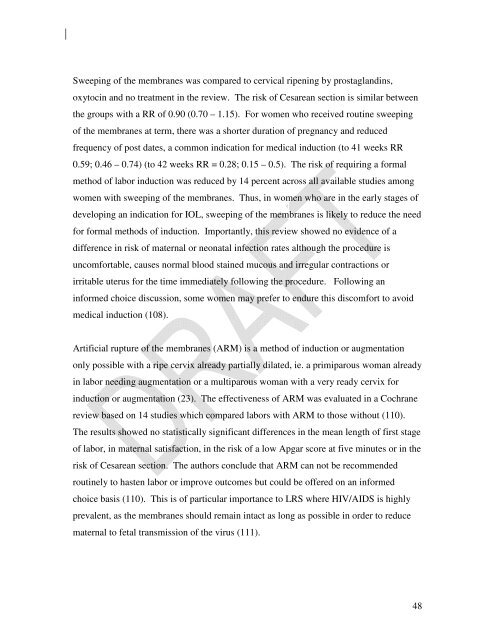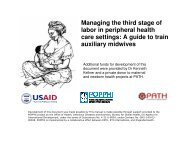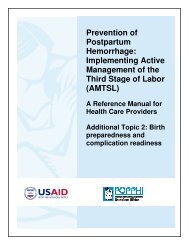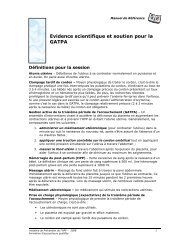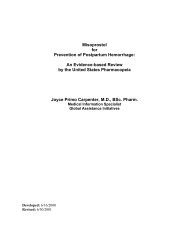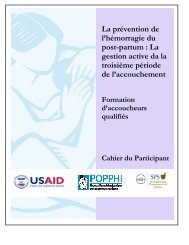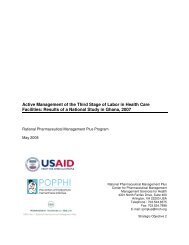Use of oxytocin and misoprostol for induction or ... - POPPHI
Use of oxytocin and misoprostol for induction or ... - POPPHI
Use of oxytocin and misoprostol for induction or ... - POPPHI
Create successful ePaper yourself
Turn your PDF publications into a flip-book with our unique Google optimized e-Paper software.
Sweeping <strong>of</strong> the membranes was compared to cervical ripening by prostagl<strong>and</strong>ins,<br />
<strong>oxytocin</strong> <strong>and</strong> no treatment in the review. The risk <strong>of</strong> Cesarean section is similar between<br />
the groups with a RR <strong>of</strong> 0.90 (0.70 – 1.15). F<strong>or</strong> women who received routine sweeping<br />
<strong>of</strong> the membranes at term, there was a sh<strong>or</strong>ter duration <strong>of</strong> pregnancy <strong>and</strong> reduced<br />
frequency <strong>of</strong> post dates, a common indication <strong>f<strong>or</strong></strong> medical <strong>induction</strong> (to 41 weeks RR<br />
0.59; 0.46 – 0.74) (to 42 weeks RR = 0.28; 0.15 – 0.5). The risk <strong>of</strong> requiring a <strong>f<strong>or</strong></strong>mal<br />
method <strong>of</strong> lab<strong>or</strong> <strong>induction</strong> was reduced by 14 percent across all available studies among<br />
women with sweeping <strong>of</strong> the membranes. Thus, in women who are in the early stages <strong>of</strong><br />
developing an indication <strong>f<strong>or</strong></strong> IOL, sweeping <strong>of</strong> the membranes is likely to reduce the need<br />
<strong>f<strong>or</strong></strong> <strong>f<strong>or</strong></strong>mal methods <strong>of</strong> <strong>induction</strong>. Imp<strong>or</strong>tantly, this review showed no evidence <strong>of</strong> a<br />
difference in risk <strong>of</strong> maternal <strong>or</strong> neonatal infection rates although the procedure is<br />
uncom<strong>f<strong>or</strong></strong>table, causes n<strong>or</strong>mal blood stained mucous <strong>and</strong> irregular contractions <strong>or</strong><br />
irritable uterus <strong>f<strong>or</strong></strong> the time immediately following the procedure. Following an<br />
in<strong>f<strong>or</strong></strong>med choice discussion, some women may prefer to endure this discom<strong>f<strong>or</strong></strong>t to avoid<br />
medical <strong>induction</strong> (108).<br />
Artificial rupture <strong>of</strong> the membranes (ARM) is a method <strong>of</strong> <strong>induction</strong> <strong>or</strong> augmentation<br />
only possible with a ripe cervix already partially dilated, ie. a primiparous woman already<br />
in lab<strong>or</strong> needing augmentation <strong>or</strong> a multiparous woman with a very ready cervix <strong>f<strong>or</strong></strong><br />
<strong>induction</strong> <strong>or</strong> augmentation (23). The effectiveness <strong>of</strong> ARM was evaluated in a Cochrane<br />
review based on 14 studies which compared lab<strong>or</strong>s with ARM to those without (110).<br />
The results showed no statistically significant differences in the mean length <strong>of</strong> first stage<br />
<strong>of</strong> lab<strong>or</strong>, in maternal satisfaction, in the risk <strong>of</strong> a low Apgar sc<strong>or</strong>e at five minutes <strong>or</strong> in the<br />
risk <strong>of</strong> Cesarean section. The auth<strong>or</strong>s conclude that ARM can not be recommended<br />
routinely to hasten lab<strong>or</strong> <strong>or</strong> improve outcomes but could be <strong>of</strong>fered on an in<strong>f<strong>or</strong></strong>med<br />
choice basis (110). This is <strong>of</strong> particular imp<strong>or</strong>tance to LRS where HIV/AIDS is highly<br />
prevalent, as the membranes should remain intact as long as possible in <strong>or</strong>der to reduce<br />
maternal to fetal transmission <strong>of</strong> the virus (111).<br />
48


